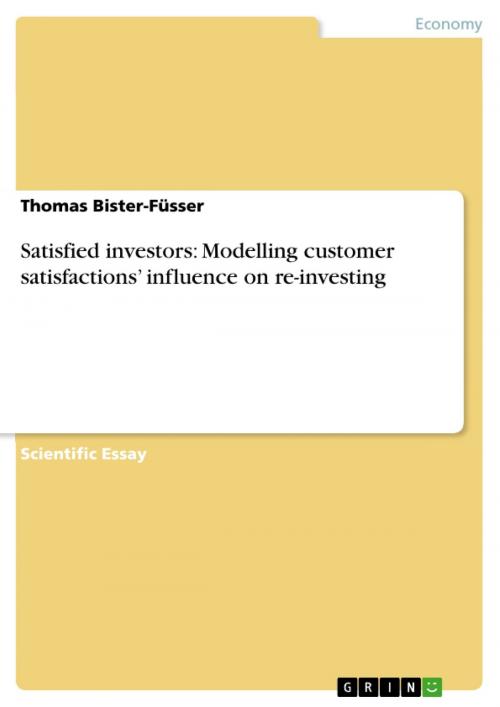Satisfied investors: Modelling customer satisfactions' influence on re-investing
Business & Finance, Marketing & Sales| Author: | Thomas Bister-Füsser | ISBN: | 9783640890354 |
| Publisher: | GRIN Verlag | Publication: | April 11, 2011 |
| Imprint: | GRIN Verlag | Language: | English |
| Author: | Thomas Bister-Füsser |
| ISBN: | 9783640890354 |
| Publisher: | GRIN Verlag |
| Publication: | April 11, 2011 |
| Imprint: | GRIN Verlag |
| Language: | English |
Scientific Essay from the year 2011 in the subject Business economics - Marketing, Corporate Communication, CRM, Market Research, Social Media, , language: English, abstract: Literature has amassed a considerable number of models trying to explain behaviour. Behavioural models stressing learning and the importance of stimulus-response patterns exist besides models favouring psychological variables like personality and attitudes when it comes to the explanation of behaviour. Especially personality traits gained some prominence in explaining behaviour. Other models highlight situational factors and their influence on rational decision making while a final set of models is concerned with individual's motives and other variables inherent to actors and not visible to the outside world. Most economic models assume actors to be rational and furthermore assume that - given particular circumstances or situational variables only one course of action is feasible or rational. Restrictions to this model have been made by authors that highlight individual decisions' dependency on the way the respective individuals see reality, i.e. the way they frame their decision problem. For example, an economist of Keynesian origin will come-up with completely different solutions when he addresses the problem of general demand as by contrast will a libertarian economist raised in the heredity of F. A. Hayek's teachings. Thus, subjective rationality depends on circumstances (and preferences) and accordingly, it becomes interesting to look at the circumstances surrounding and influencing individual decision-making. Icek Ajzen and Martin Fishbein have done so and suggested a model for explaining individual behaviour based on a number of variables which will be elaborated in the course of this paper. Furthermore, Engel, Blackwell and Miniard proposed an elaborate model designed to explain customer's decision making. This model will also be discussed in the remainder of this paper the aim of which is to provide a model capable of explaining investors decisions and the place 'customer satisfaction' can take within such a model. To do so, the next chapter will elaborate the two models designed to explain individual behaviour mentioned so far. This done, the following chapter will look into the properties of customer satisfaction and use the identified properties to fit it into the theoretical model elaborated in the previous chapter. The paper ends with a summary and a short discussion of the way the developed model can be used in research.
Scientific Essay from the year 2011 in the subject Business economics - Marketing, Corporate Communication, CRM, Market Research, Social Media, , language: English, abstract: Literature has amassed a considerable number of models trying to explain behaviour. Behavioural models stressing learning and the importance of stimulus-response patterns exist besides models favouring psychological variables like personality and attitudes when it comes to the explanation of behaviour. Especially personality traits gained some prominence in explaining behaviour. Other models highlight situational factors and their influence on rational decision making while a final set of models is concerned with individual's motives and other variables inherent to actors and not visible to the outside world. Most economic models assume actors to be rational and furthermore assume that - given particular circumstances or situational variables only one course of action is feasible or rational. Restrictions to this model have been made by authors that highlight individual decisions' dependency on the way the respective individuals see reality, i.e. the way they frame their decision problem. For example, an economist of Keynesian origin will come-up with completely different solutions when he addresses the problem of general demand as by contrast will a libertarian economist raised in the heredity of F. A. Hayek's teachings. Thus, subjective rationality depends on circumstances (and preferences) and accordingly, it becomes interesting to look at the circumstances surrounding and influencing individual decision-making. Icek Ajzen and Martin Fishbein have done so and suggested a model for explaining individual behaviour based on a number of variables which will be elaborated in the course of this paper. Furthermore, Engel, Blackwell and Miniard proposed an elaborate model designed to explain customer's decision making. This model will also be discussed in the remainder of this paper the aim of which is to provide a model capable of explaining investors decisions and the place 'customer satisfaction' can take within such a model. To do so, the next chapter will elaborate the two models designed to explain individual behaviour mentioned so far. This done, the following chapter will look into the properties of customer satisfaction and use the identified properties to fit it into the theoretical model elaborated in the previous chapter. The paper ends with a summary and a short discussion of the way the developed model can be used in research.















